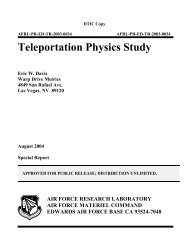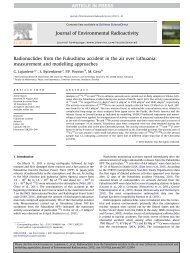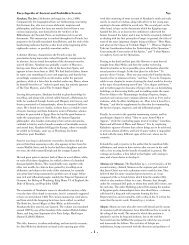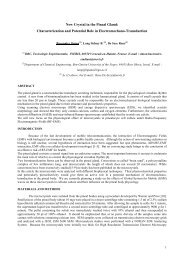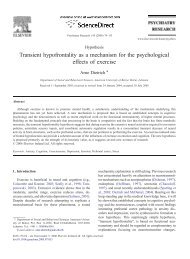or split into terrorist organizations.- Terrorists learn from others’ examples as well as from their own experience.- According to Reich (1990, p. 263), psychological explanations <strong>of</strong> terrorism have not dealt with theenormous variety and complexity <strong>of</strong> the issue. He observed, “Even the briefest review <strong>of</strong> thehistory <strong>of</strong> terrorism reveals how varied and complex a phenomenon it is, and therefore how futile itis to attribute simple, global, and general psychological characteristics to all terrorists and allterrorism. - Some types <strong>of</strong> background are over-represented in terrorists. Post (1990) cited evidencefrom several extensive studies <strong>of</strong> terrorists’ backgrounds that indicate that many <strong>of</strong> them came fromthe margins <strong>of</strong> society or were unsuccessful in their personal lives, jobs, and educations, or both. -Tedeschi and Felson (1994) emphasized that learning from the repeated success <strong>of</strong> aggressivebehavior is a major factor in encouraging groups to engage in violence.-Terrorists generally are not impulsive, either individually or in groups. On the other hand, they doexhibit the propensity to take risks.- A high proportion <strong>of</strong> terrorists appear to be stimulus seekers. They are attracted to stressfulsituations and are quickly bored when inactive (Long, 1990).- Post (1990, p.35) “The cause is not the cause. The cause, as codified in the group’s ideology,according to this line or reasoning, becomes the rationale for acts the terrorists are driven to commit.Indeed, the central argument <strong>of</strong> this position is that individuals become terrorists in order to jointerrorist groups and commit acts <strong>of</strong> terrorism.”- Terrorists use coercion as a form <strong>of</strong> social influence (Tedschi and Felson, 1994). Tedschi andFelson have identified three primary social motives for using coercion: (1) to influence others toobtain some benefit, (2) to express grievances and establish justice, and (3) to assert or defend socialidentities.- Bandura (1990, p. 186) “The path to terrorism can be shaped by fortuitous factors as well as by theconjoint influence <strong>of</strong> personal predilections and social inducements.”- Although the study <strong>of</strong> terrorism is difficult and far from complete, the evidence suggests thefollowing general characteristics <strong>of</strong> these groups, reflecting many <strong>of</strong> the principles that apply togroup violence in general: Individual and group are influenced by their environment, includingpolitical, cultural, historical, economic, and social factors. When deciding on a course <strong>of</strong> action,they weigh risks/costs vs. benefits in service <strong>of</strong> obtaining desired goals or resources. They usestrategies, tactics, and operations to create an imbalance <strong>of</strong> power in the terrorists’ favor. They workto create a strong group identity, with an “us vs. them” (in-group vs. out-group) mentality. Thisfosters groupthink. Members typically are not deranged. Although there is no personality pr<strong>of</strong>ilethat could be characterized as typical <strong>of</strong> terrorists, certain traits appear to be over-represented amonggroups’ members, including risk-taking (although they are not impulsive), low self-esteem, feelingout <strong>of</strong> control <strong>of</strong> their lives, and ascribing their failures to outside sources. Many <strong>of</strong> them come fromthe margins <strong>of</strong> society, and it is not uncommon for them to have experienced significant disruption<strong>of</strong> life during childhood. Terrorist leaders are, on the average, more hostile and narcissistic thantheir followers. Leaders manipulate followers’ emotions, and utilize coercion and disengagement <strong>of</strong>moral responses to help enable the perpetration <strong>of</strong> violence, especially on innocent people.41. Cohen, G. (1966). Women <strong>of</strong> violence: Memoir <strong>of</strong> a young terrorist. Stanford, CA: Stanford University Press.Call Number: Unable to Locate42. Collins, E., & McGovern M. (1997). Killing rage. London: Granta Books.Call Number: Editor's Annotation: The principal author, Eamon Collins, is a former IntelligenceOfficer with the IRA where he personally was responsible for several murders. In this book, whichis written as popular work more than a scholarly treatise, he recounts his story <strong>of</strong> involvement in theIRA and in terrorist activities. He focuses heavily on descriptions <strong>of</strong> the culture and context(emphasizing his personal conditions <strong>of</strong> socioeconomic deprivation) <strong>of</strong> Northern Ireland breeding akind <strong>of</strong> collective anger that was then used to justify violence and human atrocities. He attempts toportray the violence and collateral disorder starkly, and not apologetically. To the extent that thereader can rely on the author’s self-reflective insights, appraisal <strong>of</strong> social influence, and internalnarration, certain psychological lessons could potentially be inferred, although it is quite unclearhow well these experiences would generalize, even to others involved in terrorism in NorthernIreland.
43. Colvard, K. (2002). Commentary: The psychology <strong>of</strong> terrorists. British Medical Journal , 324(7333), 359.Call Number: Key Quote Summary: Terrorist groups are not usually composed <strong>of</strong> violent people, butpeople who choose to use violence as a tool to what they see as a reasonable end.- The people who choose violence are usually fairly ordinary people in extraordinary groups, and weshould look at the psychology <strong>of</strong> group processes rather than at individual psychopathology tounderstand their behaviour.- Accounts <strong>of</strong> how people become affiliated with violent groups <strong>of</strong>ten show more details aboutfriendship and courtship than political grievance.- Violent groups are usually embedded within a network <strong>of</strong> psychological and ideologicallegitimacy, which gives them both material and moral support.44. Cooper, H. H. A. (1978). Psychopaths as Terrorists. Legal Medical Quarterly, 2, 253-262.Call Number: Editor's Annotation: It would be all to easy to write that it is not necessary to be apsychopath in order to be a terrorist. In fact, it is almost certain that it does not. <strong>Terrorism</strong>, like anyother serious undertaking, requires dedication, perseverance, and a certain selflessness. These arethe many qualities that are lacking in the psychopath.-Allied to this flattening <strong>of</strong> the emotions in the psychopath is a lack <strong>of</strong> moral responsibility thatmakes his actions peculiarly ungovernable.45. Cooper, H. H. A. (1976). The terrorist and the victim . Victimology: An International Journal, 1(2), 229-239.Call Number: Unable to Locate46. Cooper, H. H. A. (1985). Voices from Troy:What are we hearing? Out thinking the terrorist: An internationalchallenge . Proceedings <strong>of</strong> the 10th annual symposium on the role <strong>of</strong> behavioral science physicalsecurity Washington, DC: Defense Nuclear Agency.Call Number: Unable to Locate47. Cooper, H. H. A. (1977). What is a terrorist? A psychological perspective. Legal Medical Quarterly, 1, 16-32.Call Number: Editor's Annotation: Shifts from question <strong>of</strong> "what is terrorism" to "what is aterrorist?"-Terrorists must develop justifications for their terrorist actions.- They also must believe it is neccessary and effective.-Terrorists are not born terrorists they become them.-Terrorists are complex human beings and are quite diverse. They must be able to detach themselvesagainst the suffering <strong>of</strong> others.-Argues that reasons we need to understand terrorists include: knowing under what circumstancesthey might kill a hostage; knowing the extent to which they might put their own lives at risk in aconfrontation; know extent <strong>of</strong> capability to use new technology.-Draws analogy between terrorists and bullies (callous and project their own pathological fears ontoothers) and between terrorists and tortures.-A somewhat dated, naive psychological description <strong>of</strong> terrorists. No research basis or theoreticalframework.48. Cordes, B. (1987). Euro terrorist talk about themselves: A look at the literature. P. Wilkinson, & A. M.Stewart (Eds), Contemporary research on terrorism (pp. 318-336). Aberdeen: Aberdeen UniversityPress.Call Number: Editor's Annotation: By using the primary materials provided by the terroriststhemselves, i.e., memoirs, statements, interviews and communiqués much information about theterrorist mindset and decision making can be gleaned.- What terrorists say about themselves is <strong>of</strong>ten more revealing than they intend.- The fundamental contradiction for terrorists is that while they are deliberately employing what wein fact regard as terrorist violence, they characterize their actions as something else.- To comprehend the terrorist mindset it is crucial to uncover the rationale, motivations andmechanisms for such denial.-This chapter takes a look at some <strong>of</strong> the dynamics <strong>of</strong> terrorism and proposes a simple framework forexamining the terrorists’ view <strong>of</strong> themselves and their actions.
- Page 2 and 3: MethodologyWe have defined terroris
- Page 4 and 5: Reference List1. Root causes of ter
- Page 6 and 7: - The experience of discrimination
- Page 8 and 9: justification across all three reli
- Page 10 and 11: 11. Bandura, A. (2003). The origins
- Page 12 and 13: ather then from their own volition.
- Page 14 and 15: -If the women's liberation movement
- Page 16 and 17: technology and science.-Although mo
- Page 18 and 19: effects that help facilitate violen
- Page 20 and 21: academic fields of study.-Terrorism
- Page 22 and 23: one’s own group and towards other
- Page 24 and 25: marked cars, do not mount stationar
- Page 26 and 27: ethnic group: he or she must also s
- Page 28 and 29: third option involves becoming 'thr
- Page 30 and 31: discriminative stimuli that are tem
- Page 32 and 33: him to disengage from the organizat
- Page 36 and 37: -Part of the complexity of terroris
- Page 38 and 39: focuses on the depressive character
- Page 40 and 41: Call Number: Editor's Annotation: W
- Page 42 and 43: unanimity has only infrequently ser
- Page 44 and 45: sensitivity to betrayal, and securi
- Page 46 and 47: -People may not support a resistanc
- Page 48 and 49: splinter off from the main organiza
- Page 50 and 51: seduced by the lures of omnipotence
- Page 52 and 53: Most past research findings are bas
- Page 54 and 55: terrorist groups break away from la
- Page 56 and 57: -A second general theory of organiz
- Page 58 and 59: -Violence was justified, first of a
- Page 60 and 61: -Conclusion: When disruptive social
- Page 62 and 63: Call Number: Editor's Annotation: C
- Page 64 and 65: terrorist groups even between group
- Page 66 and 67: grievances and his concomitant will
- Page 68 and 69: -Yet forecasting requires theory, t
- Page 70 and 71: highly organized or institutionaliz
- Page 72 and 73: -Underprivileged groups are likely
- Page 74 and 75: situations where the terrorist moti
- Page 76 and 77: 1977), including in the Palestinian
- Page 78 and 79: -Nor can a general theory of civil
- Page 80 and 81: extent to which deprived occupy org
- Page 82 and 83: -The necessary dependence on new-se
- Page 84 and 85:
it relates specifically to the regi
- Page 86 and 87:
or class of phenomena, within a giv
- Page 88 and 89:
progress in the analysis of terrori
- Page 90 and 91:
-Loyalty in the face of continuing
- Page 92 and 93:
Republican electorate and also with
- Page 94 and 95:
ecent 1994-96 cease-fire.- certain
- Page 96 and 97:
e reported in news media. Even if a
- Page 98:
eaccompanied back to Italy where he
- Page 101 and 102:
(non believers) facilitates violenc
- Page 103 and 104:
disagreements and disharmony. There
- Page 105 and 106:
autonomy, colonial liberation, raci
- Page 107 and 108:
introduced as the seminal, grass ro
- Page 109 and 110:
identity over personal and familiar
- Page 111 and 112:
-Finally, a comprehensive policy to
- Page 113 and 114:
-It would be naive to think of suic
- Page 115 and 116:
negotiator for the specific situati
- Page 117 and 118:
efused to fight in the Lebanese war
- Page 119 and 120:
-It has been our impression from fr
- Page 121 and 122:
-Many efforts have been made to cat
- Page 123 and 124:
drives that are brought about by (a
- Page 125 and 126:
word.-Consider now the value of ter
- Page 127 and 128:
-The interaction of deprivation and
- Page 129 and 130:
maximize its expected political ret
- Page 131 and 132:
insights into the underlying dynami
- Page 133 and 134:
lengths to secure materials and tec
- Page 135 and 136:
influencing the success of amnesty
- Page 137 and 138:
-The great diversity of terrorism a
- Page 139 and 140:
205. Monroe, K. R., & Kreidie, L. H
- Page 141 and 142:
Call Number: Published Abstract: Di
- Page 143 and 144:
physiological and psychiatric appro
- Page 145 and 146:
2001, suicide attacks amount to 3%
- Page 147 and 148:
numbersas an offering to the bloodt
- Page 149 and 150:
etween radical family involvement a
- Page 151 and 152:
there is no ambivalence concerning
- Page 153 and 154:
dynamics the ‘anarchic-ideologues
- Page 155 and 156:
especially with the parents (33 per
- Page 157 and 158:
esult.-The world is divided into tw
- Page 159 and 160:
pressure from supporters, internal
- Page 161 and 162:
- 1.00 Historical, Cultural, and Co
- Page 163 and 164:
personal rivalry- An extremist fact
- Page 165 and 166:
national governments. At this preli
- Page 167 and 168:
-Normative Orientations directs peo
- Page 169 and 170:
Sicarii views. Insurrection was onl
- Page 171 and 172:
-To have a space of one’s own is
- Page 173 and 174:
outside the normal range of violenc
- Page 175 and 176:
-Various governments sought to curb
- Page 177 and 178:
e older (i.e., 40's-50's)-Sex: Pred
- Page 179 and 180:
liberation Tigers of Tamil Ealam (L
- Page 181 and 182:
electronic communication and inform
- Page 183 and 184:
any other topic on which so much ha
- Page 185 and 186:
has exposed some particular cause b
- Page 187 and 188:
and alone. Ultimately, terrorism re
- Page 189 and 190:
-Conclusions: The motives for param
- Page 191 and 192:
272. Sprinzak, E. (2001). Rational
- Page 193 and 194:
-One way for individuals to handle
- Page 195 and 196:
-Theories of Hate: Fromm (1973/1992
- Page 197 and 198:
student tells the convict his misde
- Page 199 and 200:
literate in EnglishPoor verbal skil
- Page 201 and 202:
features: focusing; personalized vi
- Page 203 and 204:
-Even if idiosyncratic, the process
- Page 205 and 206:
some other agencies’ inaction. We
- Page 207 and 208:
-The RWA is probably the instrument
- Page 209 and 210:
students choose Communist student o
- Page 211 and 212:
state-oriented tradition: by taking
- Page 213 and 214:
phase of semi legality.-Helpers and
- Page 215 and 216:
the neo-Fascists were over 40 years
- Page 217 and 218:
commonality can be found in the utt
- Page 219 and 220:
geographical, and we consider it in
- Page 221:
-The violence struggle against the



